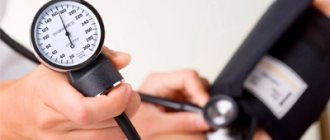Vegetative-vascular dystonia: “mysteries” of diagnosis
Over the years, attitudes towards the diagnosis of VSD have changed both among doctors and patients. Together with a neurologist of the highest category, candidate of medical sciences, head of the consultative and diagnostic department of the clinic of the Federal State Budgetary Institution "Research Institute of Therapy and Preventive Medicine" SB RAS Svetlana Duma, we decided to debunk the myths with which this disease is associated today.
Vegetative-vascular dystonia is indeed a fairly new phenomenon. Knowledge of the autonomic nervous system was first developed only in the twentieth century by academician Alexander Wein. However, today 80% of patients who consult a neurologist have a disorder that doctors characterize as vegetative-vascular dystonia. At the same time, the number of such patients is growing rapidly, and antidepressants, which are used to treat VSD, have long taken first place among the best-selling medications. During the short history of its existence, a clear understanding of this disease has not emerged among patients.
Myth 1.
VSD is a vascular disorder.
In fact
This is an imbalance of all organs and systems for the coordination of which the autonomic nervous system is responsible.
According to the definition of Alexander Wein, VSD is a violation of various functions of the body, usually somatic, that is, physically tangible. The cause of these disorders is a failure in the nervous regulation carried out by the autonomic nervous system. It is she who is responsible for synchronizing the processes occurring in the internal organs.
Myth 2.
The cause of VSD is a chronic disease.In fact
Chronic disease can trigger VSD in older people, but in most cases the cause of VSD is a nervous disorder.
Another exception is adolescents whose hormonal levels change during puberty, as well as people with endocrine pathologies. And yet, according to neurologists, only 20% of patients with vegetative-vascular dystonia have a primary pathology of any organ or system.
“In middle-aged and older people, indeed, VSD can develop against the background of some kind of somatic disease
, says Svetlana Duma.
– This could be pathology of the gastrointestinal tract, vascular diseases of the heart or brain, neurodegenerative diseases, consequences of injuries and infections.
But if we talk about the most common cause of VSD, then these are neurotic disorders - anxiety or anxiety combined with depression.” One of the most complex manifestations of VSD, which has developed on a nervous basis, is panic attacks, that is, sudden inexplicable attacks of fear, accompanied by bodily discomfort. As a rule, these symptoms occur when the patient delays treatment of the pathology without recognizing its psychological, or rather psychiatric, nature.
Myth 3.
There is no diagnosis of VSD.In fact
There is such a diagnosis in disease classifiers, but it is not in its “right” place, hence its “non-existence”: the diagnosis is indeed not somatic, but it is not officially classified as a nervous disease.
Since the true cause of most cases of VSD is a disorder of a nervous nature, in the classification of diseases it, logically, should belong to the section of nervous diseases.
However, due to established practice, the diagnosis of VSD is located among somatic (bodily) diseases. According to doctors, the reason for this discrepancy is that patients with vegetative-vascular dystonia are in no hurry to turn to psychiatric specialists.
“If we exclude an organic cause, we diagnose VSD on the background of an anxiety disorder, although the anxiety disorder comes first here
, says Svetlana Duma.
– If such a patient gets to a psychiatrist or psychotherapist, he will be given, in fact, the correct diagnosis. This will be, for example, a somatoform or anxiety disorder, due to which VSD syndrome develops. This bureaucratic discrepancy is apparently due to the fact that people do not want to go to the right doctor.”
Myth 4.
A doctor may miss a serious disease by diagnosing VSD.In fact
The patient is always carefully examined, even if he is “recognized” as a patient with VSD.
The diagnosis of VSD is made by exclusion. This means that when examining a patient with suspected vegetative-vascular dystonia, all possible somatic pathologies are excluded.
“Experienced neurologists immediately see a patient with VSD, but they cannot take upon themselves the responsibility of diagnosing him without additional examinations,
– explains the doctor.
– We look at the probable objective cause that is causing the problem, and if we do not confirm it, we make a diagnosis of “VSD.”
The patient's examinations include a health check according to a certain standard, which includes an ECG and a blood test. In addition, the patient’s endocrine system is checked - the condition of the thyroid gland, pituitary gland, hypothalamus and adrenal glands.
Myth 5.
VSD is the second name for another disease.In fact
Other names for VSD are related to the fact that at one time they tried to rename this diagnosis, but now it has no official synonyms.
“We have a variant of the diagnosis that, in general, has become obsolete - neurocirculatory dystonia
, says Svetlana Duma.
– It implies slight fluctuations in pressure, minor rhythm disturbances. Now this diagnosis is not made; instead, VSD is given. They tried to rename VSD, for example, there was a syndrome of vegetative dystonia, Alexander Moiseevich Vein proposed “psycho-vegetative syndrome.” The name may vary, but the classification remains “VSD”.
Myth 6.
Symptoms of VSD are concentrated in the head area.In fact
Symptoms can manifest themselves both from the gastrointestinal tract and as pain in the chest.
Neurologists call VSD a multisystem diagnosis: the disorder attacks the patient from an unexpected direction, and sometimes from several sides at once. A patient with VSD may complain, for example, of pain in the heart area, but when questioning the doctor, it turns out that he has been tormented by intestinal problems for a long time, chills appear inappropriately, and sometimes his body temperature fluctuates.
“Very often, patients with VSD complain of pain, from different sides. One of the variants of autonomic dysregulation is functional disorders of the gastrointestinal tract,
— says Svetlana Duma.
– In recent years, they have been encountered so often that gastroenterologists have identified them as a separate category. In the 19th century, these disorders were called intestinal neurosis; now they are functional disorders of the gastrointestinal tract.”
Myth 7.
VSD is a congenital pathology, and at the same time “lifelong”.In fact
VSD is usually acquired in a stressful situation, and it is possible to get rid of dystonia with proper treatment.
According to the doctor, the success of treatment depends on individual “brain chemistry.” As a rule, treatment is quite long, but it does not last for the rest of your life. At the same time, the disease can catch a person, as they say, out of the blue, because almost everyone is exposed to stress today. But it is a stressful situation that often becomes a trigger for symptoms of VSD.
“In the 90s in Novosibirsk there were small echoes of the earthquake, to which many residents reacted with fear and deterioration in health,
- the doctor recalls.
– Then a whole layer of so-called vegetatives went to neurologists.
Sometimes in a stressful situation a person mobilizes and copes with the problem, sometimes very successfully. Often after such situations an anxiety disorder occurs because the body is overstressed and is unable to relax.” How to treat?
Unfortunately, a patient with VSD due to a nervous disorder today is in a difficult situation. On the one hand, he should contact a psychiatrist, but specialists in mental illness, as a rule, do not find sufficient grounds for treatment. The services of their alternative, psychotherapists, are usually not cheap. However, in not very advanced cases, patients with a disorder of the autonomic system can be helped by a neurologist or therapist. According to the doctor, it is they who see the vast majority of such patients.
“In Soviet times, therapists were turned into psychotherapists, but now, of course, there is no such thing,
– says Svetlana Duma.
“ But today a therapist can prescribe first-line antidepressants, which are allowed for everyone.
In this case, it is the nervous disease that needs to be treated – anxiety or anxiety-depressive disorder. We can prescribe mild medications that stabilize autonomic activity, but if the nervous disorder is not treated, after some time all the symptoms will return.”
Prevention of vegetative-vascular dystonia
But prevention of nervous VSD is simple. If it is hardly possible to protect yourself from stress in modern conditions, then everyone can prevent nervous overexertion, the doctor assures. To do this, you just need to set aside some time for rest every day and during the week.
“The body is like a spring; if you constantly strain it, it will react in the form of imbalance,” says Svetlana Duma. – It is also important to learn to enjoy the little things. If a person knows how to have fun every day, that’s great – it improves his health.”
Related articles:
Under the pressure of depression
Panic attacks: silent horror
Symptoms
Vegetative-vascular dystonia in adult sick people has different manifestations. Most often, VSD has a hidden course. Under the influence of increased stress or other negative circumstances, attacks occur. They occur suddenly and significantly impair the quality of life. Sympathetic dystonia is worse experienced by older people because they have chronic diseases.
There are manifestations of other diseases that are not directly related to the autonomic nervous system. If there are indicators of damage in the area of the heart and blood vessels, the neurologist diagnoses the presence of VSD.
In accordance with scientific articles, the signs of the diagnosis of VSD are:
- headaches - they always differ in severity and duration;
- dizziness;
- severe sweating (increased sweat secretion from the sebaceous glands);
- weakness and high fatigue;
- increased heart rate;
- noise in ears;
- fluctuations in body temperature;
- increased drowsiness, apathy;
- sudden mood changes;
- severe anxiety;
- panic attacks;
- darkening of the eyes, lightheadedness;
- hypochondria.
Panic attacks
Vascular parasympathetic pathology in patients is accompanied by panic attacks. This term refers to a strong fear of death that grips a person. The patient develops anxiety, turning into real horror.
The body sends impulses about danger, but does not find a way out of the situation. Such an attack lasts on average a quarter of an hour, the state of health is slowly restored.
Inability to fall asleep
Sleep problems are typical for all patients with VSD syndrome. Dysfunction in the nervous system manifests itself in the form of insomnia or increased sleepiness. Such symptoms are caused by various disorders in the function of the autonomic nervous system. This provokes a change in biorhythms.
With this disease, it is difficult for the patient to relax. His sleep is short-term. This causes increased sleepiness during the day. When the nervous system is damaged, memory is impaired, concentration deteriorates, and performance decreases. A long absence of normal sleep leads to the appearance of psycho-emotional abnormalities. The nervous system cannot cope with the stress, breakdowns appear.
Emotional instability
It is a consequence of insomnia. A person feels tired, resulting in sudden mood swings. After rest, the patient is quite cheerful, but after a certain time he begins to feel sad or even aggressive.
Change in skin tone
Caused by damage to vascular tone. The patient experiences a rapid flow of blood to the skin and an equally rapid outflow. The skin turns red and appears pale. Similar problems occur during emotional arousal and after increased physical exertion.
Respiratory disorders
Dyspnea with parasympathetic VSD is caused by changes in the innervation of the bronchi. Under the influence of respiratory infections, stress, increased fatigue, and physical exertion, symptoms of shortness of breath appear. Middle-aged or elderly patients experience suffocation, chest discomfort, and the main complication is bronchial asthma. This symptom is associated with cardiac pathologies, which makes diagnosis difficult.
Weather dependent
The autonomic system helps the patient’s body adapt to any weather conditions. If its work is disrupted, a dependence on the climate occurs. High or low atmospheric pressure, hot weather, wind, and precipitation provoke signs of VSD diagnosis such as weakness, headaches, loss of appetite and decreased ability to work.
Digestive disorders
The autonomic system regulates the function of the digestive organs. If this area does not work properly, excessive appetite or its complete absence is observed. During the period of vegetative-vascular dystonia, manifestations of gastritis or gastric ulcer occur. The symptoms of the disease vary from person to person. Constipation or diarrhea, intestinal spasms, pain, and inflammation of the mucous membranes are observed.
Disorders of the genitourinary system
Autonomic dystonia syndrome is accompanied by increased urination and pain in the area of genital function, but they are not associated with pathologies. This is due to insufficient innervation of the pelvic organs. In women, the course of dystonia occurs with cycle deviations and decreased libido. Men may have problems with potency and the appearance of signals of prostate damage.
Dizziness
The cause of this symptom of the disease is a violation of cerebral vascular tone. Their condition is affected by:
- mental overload;
- stress;
- heredity;
- diabetes;
- nervous system disorders;
- lesions of the thyroid gland.
Headache
Autonomic dystonia syndrome causes other symptoms in the patient. An important indicator of VSD is headache. It manifests itself in people who are susceptible to fear and experience strong emotions after stress.
The headache during the illness is not intense, it increases when the head is tilted. Other signs of VSD are possible - fainting, dizziness, nausea, tinnitus, unsteadiness of gait.
Nutrition correction
Proper nutrition should become a habit for every person suffering from vegetative-vascular dystonia. The diet should be balanced; it is recommended to eat 300-400 g of vegetables and herbs per day, but do not overuse fruits (1-2 per day or 1 glass of berries). Nutritionists advise giving up large portions of food and giving preference to fractional meals (small but frequent portions). Optimally, eat food 5-6 times a day, every 2.5-3 hours.
The following should be excluded from the diet:
- fatty, fried and highly salted foods;
- sausages;
- semi-finished products;
- carbonated and alcoholic drinks.
The best way to cook food is stewing, boiling and baking.
The diet should consist of foods rich in vitamins and minerals involved in the synthesis of connective tissue fibers:
- whole grain products;
- fermented milk products;
- lean meats;
- fish and seafood;
- raw vegetables and fruits.
Especially useful are foods containing large amounts of vitamin E, a vitamin that increases the elasticity of blood vessels and prevents blood clots:
- vegetable oils;
- beef liver;
- eggs;
- soy;
- legumes;
- nuts;
- avocado.







